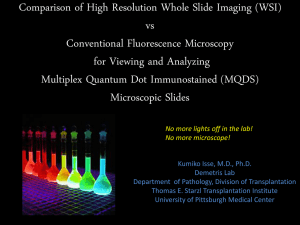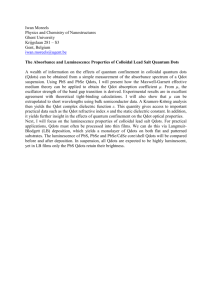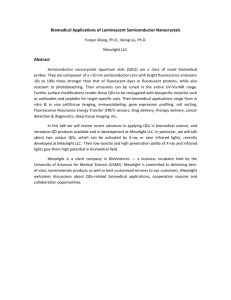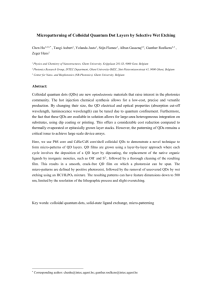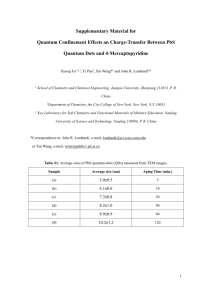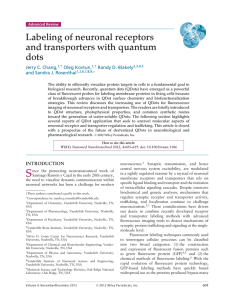2004 Debye Lecture 4 C. B. Murray Quantum Dot Applications: Sun Screen
advertisement
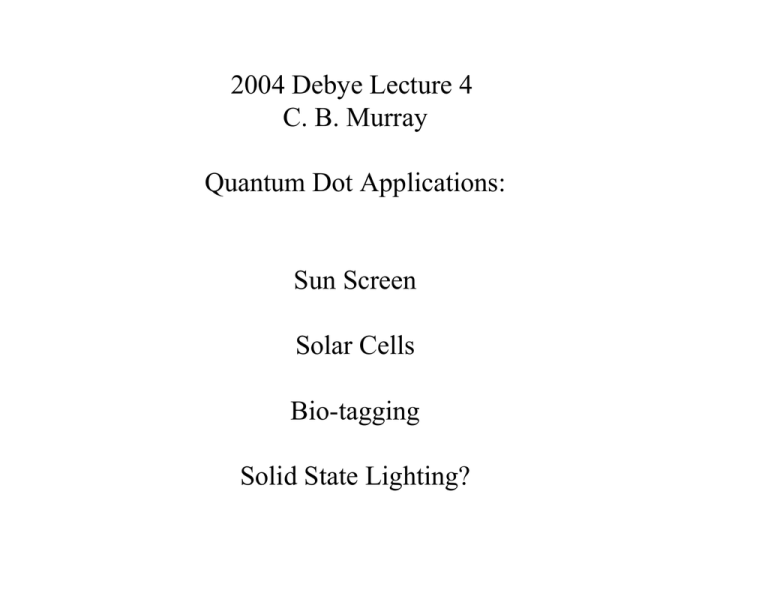
2004 Debye Lecture 4 C. B. Murray Quantum Dot Applications: Sun Screen Solar Cells Bio-tagging Solid State Lighting? Quantum Dot Solar cells Nanocrystal Solar Cells Double-labeling of mitochondria and microtubules in NIH 3T3 cells. The mitochondria were labeled with human antimitochondria antibodies, goat anti-human IgG-biotin and Qdot® 605 Streptavidin Conjugate. After blocking the samples with biotin, microtubules were stained with mouse anti-tubulin, goat anti-mouse IgG-biotin and Qdot 525 Streptavidin Conjugate. The nuclei were counterstained with Hoechst 33342. Highly efficient double-labeling with Qdot Protein A Conjugate and Qdot Streptavidin Conjugate. Fixed human epithelial cells were incubated with a mixture of mouse antihistones antibody and biotinylated phalloidin. Nuclear histones (red) and actin filaments (pseudocolored green) were subsequently labeled with Qdot 605 Protein A Conjugate and Qdot 655 Streptavidin Conjugate respectively. Since the emission spectra of Qdot Conjugates are narrow, symmetric and lack a long emission tail typical of conventional organic dyes, there was no detectable cross-talk between the two detection channels although the emission peaks of the two conjugates are just 50 nm apart. Staining of microtubules with Qdot Streptavidin Conjugate. NIH 3T3 mouse fibroblast cells were incubated sequentially with mouse anti-tubulin antibody, biotinylated antimouse IgG and Qdot 605 Streptavidin Conjugate. The nuclei were counterstained with Hoechst 33342. Double-labeling of mitochondria and histones in human epithelial cells. The cells were incubated with a mixture of human antimitochondria antibody and mouse anti-histones antibody. The mitochondria (green) were labeled with Qdot 525 Streptavidin Conjugated after the cells were incubated with biotinylated goat antihuman IgG. After blocking with biotin, the cells were sequentially incubated with biotinylated goat anti-mouse IgG and Qdot 605 Streptavidin Conjugate (red). Photostability comparison between Qdot 605 and Alexa® 488 conjugates. Microtubules in a 3T3 cell were labeled with Qdot 605 Streptavidin Conjugate (red) and nuclear antigens were stained green with Alexa 488 conjugated to anti-human IgG. The specimens were continuously illuminated for 3 min with light from a 100W mercury lamp under a 100X/1.30 oil objective. An excitation filter (ex 485 + 20 nm) was used to excite both Alexa 488 and Qdot 605 conjugates. Emission filters em 535 + 10 nm and em 605 + 10 nm on a motorized filter wheel were used to collect Alexa 488 and Qdot 605 signals respectively. Images were captured with a cooled CCD camera at 10 second intervals for each color automatically. Images at 0, 20, 60, 120 and 180 seconds are shown. Reprinted with permission from Nature Biotechnology 22:93-97 (2004). Sentinel lymph node identification and removal from a pig using a NIR quantum dot indicator. Type II near-infrared-emitting quantum dots were injected into a primary tumor in a near-human sized pig (Panel A, large green region at right). The false-color image clearly shows transport of the quantum dots through lymph vessels to a nearby lymph node (smaller green area at left) even when imaged non-invasively through the skin. In Panels B-D are depicted the surgical removal of the lymph node. A visible light color image is given in B. The black and white image in C is the same image as viewed through a NIR-sensitive camera. In Panel D, the images have been merged and the NIR signal false-colored green as in Panel A. In vivo Fluorescence Imaging. The images below were acquired following tail vein injections of 550 nmemitting Qdot® nanocrystals. In Panel A, dermal capillaries (~100 µm deep) are easily discernable. In Panel B, blood flow has been imaged using the line scan indicated by the dashed line in A. This image has been blown up in Panel C where the striated appearance is due to heartbeats. A comparison image using FITC instead of Qdot nanocrystals is given in Panel D. In Panel E, adipose tissue surrounding the ovaries has been imaged using the Qdot nanocrystals. Combining several images results in the composite view given in F. Reprinted with permission from SCIENCE 300:1434-36 (2003). Copyright 2003 American Association for the Advancement of Science. Figure 1. QD-micelle formation and characterization. (A) Schematic of singleQD encapsulation in a phospholipid blockcopolymer micelle. (B) TEM image of QDmicelles dried on a carbon-Formvar-coated 200-mesh nickel grid. Only the QDs inside the micelle core are visible. The particles appear evenly spread on the surface. Although some clusters of two to four QDs are visible, most of the QDs are isolated, suggesting that a majority of micelles contain a single QD. (C) TEM image of the phospholipid layer obtained by negative staining with 1% PTA (phosphotungstic acid) at pH 7. With this technique, both the QD and the micelle can be visualized at the same time. The QD (dark spot) appears surrounded by a white disk of unstained phospholipids that stands out against the stained background. A JEOL 100CX TEM was operated at 80 kV. Figure 2. Conjugation of QD-micelles with DNA. (A) Schematic of the QD-micelle conjugation with single-stranded DNA (ssDNA). (B and C) Hybridization of QD-micelles conjugated with DNA to surface-bound ssDNA. 5'-Biotin-modified ssDNA (5'-TTACTCGAGGGATCCTAGTC-3') was attached to streptavidin-modified 4% agarose beads. A PBS solution containing QD-micelles conjugated with 20-base-long ssDNA was added to the bead solution and incubated at room temperature for more than 10 min. After rinsing once with PBS, the bead fluorescence is measured with an optical microscope. In (B), the oligonucleotides bound to the agarose beads are not complementary to the oligonucleotides bound to the QDmicelle. In (C), they are complementary. (D) Fluorescence image of aggregates of DNA-QD-micelles obtained by mixing equal amounts of two batches of QD-micelles conjugated with complementary single-stranded oligonucleotides. (E) TEM image of the same sample as in (D). The fluorescence images were obtained with Chroma filter set 41015 (wild-type GFP longpass emission with a 50-nm-wide band-pass excitation centered at 450 nm) mounted on a Zeiss fluorescence microscope. The samples were excited with a 50-W mercury lamp. Images were recorded with a color digital camera (AxioCam HR, Zeiss) and AxioVision Viewer software (Zeiss). In all experiments the QDs had a 3.5-nm-diameter CdSe core and ZnS outer layer. These QDs absorb light with wavelengths <515 nm and emit light at ~550 nm. Their extinction coefficient is 8.4 × 105 M 1 cm 1 (29). ig. 3. QD labeling of Xenopus embryos at different stages and specific QD intracellular localizations. (A) Schematic showing the experimental strategy. QD-micelles, as in Fig. 2, were injected into an individual blastomere during very early cleavage stages. Between 1.5 and 3 nl of a 2.3 µM suspension of QDs were injected, corresponding to 2.1 × 109 to 4.2 × 109 injected particles per cell. Embryos were then cultured until they reached different stages of development, and imaging was done as in Fig. 2. In (B) to (E), transmission and fluorescence images have been superposed. (B) Injection of one cell out of an eight-cellstage embryo resulted in labeling of individual blastomeres. (C) Same embryo shown 1 hour later. The daughter cells of the injected blastomere are labeled (D) and at a later stage (E) show two neurula embryos, which were injected into a single cell at the eight-cell-stage in the animal pole. The QDs can be visualized through the pigmented layer of the epidermis. (F) Intracellular labeling of an axon (arrow) and somites at tadpole stage 40. The QD-micelles migrate into axons all the way to growth cones. In the somites, the QDmicelle seems to localize in subcellular structures. (G) QDs localized in the nucleus during mid-blastula stages. This localization is reduced in later stages of the development. (H) Labeled neural crest cells migrating into the branchial arches. (I) QD fluorescence observed in the gut of an injected embryo. Bars: (B) to (E), (H), and (I), 0.5 mm; (F) and (G), 30 µm. Fig. 4. Comparison of QD and RG-D (Rhodamine Green Dextran, Molecular Probes) for resistance to photobleaching. QDs and injection amounts are similar to those used in Fig. 3. For RG-D, 1 nl of a 25 mg/ml solution was injected. (A to C) Consecutive images of RG-D-injected Xenopus animal pole blastomeres. (D to F) Consecutive images of QD-injected Xenopus animal pole blastomeres. During each experiment, the injected embryos were excited continuously at 450 nm. (G) Graph representing the variation of fluorescence intensity of one cell of the RG-D-injected embryo (dotted line) and of one cell of the QD-injected embryo (solid line). Bars, 30 µm. Solid State lighting- Electroluminescent Quantum Dot Nanocrystal Devices Evident Technologies has demonstrated direct electroluminescent emission at visible wavelengths and at IR wavelengths important for optical telecommunications. The wavelength and the bandwidth of the emitted light was directly determined by the size and composition of the dispersed nanocrystals within the device. The company has expertise in modifying the nanocrystal surfaces with molecules that facilitate charge transport into the nanocrystals from the conducting matrixes. Using nanocrystals (quantum dots), vibrant colors including blue and deep blues can be generated. Because of the inorganic nature of the particles, they are inherently stable and can increase the operational lifetimes of the ensuing devices. LAUREN ROHWER displays the two solid-state lightemitting devices using quantum dots her team has developed. One is blue and the other is white. (Photo by Randy Montoya) Download 300dpi JPEG image, ‘Laurendots.jpg’, 1MB (Media are welcome to download/publish this image with related news stories.) The approach is based on encapsulating semiconductor quantum dots — nanoparticles approximately one billionth of a meter in size — and engineering their surfaces so they efficiently emit visible light when excited by near-ultraviolet (UV) lightemitting diodes (LEDs). The quantum dots strongly absorb light in the near UV range and re-emit visible light that has its color determined by both their size and surface chemistry.

